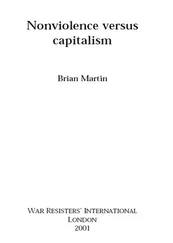An examination of what and how information might need to be collected as part of a social defence system; in other words, an examination of social defence intelligence services.
Most of these research projects would require years of investigation. Their scope is not revealed by these brief descriptions. This list hints at the vast amount of research that could be carried out into social defence. Indeed, given that the military spends billions of dollars each year on research, it can be anticipated that a full-scale social defence system might spawn a similar mass of research. Therefore, the 24 projects listed here from de Valk’s book would only be the barest beginning of a full-scale social defence research effort.
Most of the 24 projects are social rather than technological: they deal largely with history, psychology, politics, ideology, strategy and policy. Only three — the third, fourth and fifth as listed — provide any focus on technology. This gives an indication of the relative neglect of the technological dimension in the nonviolence field. Indeed, searching through writings on nonviolence, there is remarkably little attention to technology, so it is worth mentioning those few writers who deal with it.
The earliest and most important was novelist and essayist Aldous Huxley, whose ideas are described in the prologue. Then there is leading peace researcher Johan Galtung, who has made specific suggestions for specific technological developments that would aid a social defence system, especially in his 1968 paper “On the strategy of nonmilitary defense: some proposals and problems.” He suggests, for example, that research could be done into how to design a country’s physical equipment so that it can be sabotaged appropriately. Since Galtung’s ideas are so insightful, it is worth quoting his entire account on this point.
The task would not be to blow up a factory completely,
but to remove that minimum part which would cause maximum uselessness
. Which part this is and how much will have to be removed would be a subject of meticulous calculation, where the availability of substitutes, or substitute uses of the remaining parts of the factory, would play a great role. Such calculations are well within the reach of modern, computerized societies. Thus, in an airplane it would probably not lead to the removal of the propeller (since the engine could then be used for other purposes), but of some small, highly specialized part of the engine, and so on. In the tertiary sectors of society, it would generally be easier since these sectors (except transport and communication) are mainly concerned with symbolic activity, so that the removal or destruction of files, codes, manuals of procedure, membership files, population data, means of financial tranactions, etc., should cause a high degree of uselessness. Transport and communication are also relatively easily reduced in efficiency. But in the primary sector it would generally be less easy, since the facilities here are more like territory. However, pits can be undermined and fields can be rendered useless by chemical means — and better technology could make both strategies time dependent, so that even though the destruction would be irreversible for the time being, it would still only be temporary. It might be argued that all the enemy then would have to do, would be to sit down and wait for usefulness to recur — but the counter-strategy against that again would be to calculate the timing of destruction as well as recovery, or to have options for repeated destruction.
[2] . Johan Galtung, “On the strategy of nonmilitary defense: some proposals and problems,” in Johan Galtung, Peace, War and Defense. Essays in Peace Research , Volume Two (Copenhagen: Christian Ejlers, 1976), pp. 378-426, 466-472, quote at pp. 390-391.
Richard Wendell Fogg raised a few relevant points, for example noting the importance of broadcasting to the population of an aggressor’s country. [3] . R. W. Fogg, “A technical equivalent of war,” in H. Chestnut (ed.), Contributions of Technology to International Conflict Resolution (Oxford: Pergamon Press, 1986), pp. 113-120.
Eminent nonviolence scholar Gene Sharp devoted a page to general comments about the need to question standard assumptions about large technological scale and centralised control over energy, food, production and transport; he suggested that attention should be paid to technology with the aim of diffusing social power. [4] . Gene Sharp, Social Power and Political Freedom (Boston: Porter Sargent, 1980), pp. 403-404.
Aside from these authors, though, little had previously been done before my own work. The contrast with the enormous military research and development programmes is striking.
There are two obvious groups who might have been expected to undertake studies of science and technology for nonviolent struggle. The first is activists and scholars in the field of nonviolent action. As far as activists go, there have been untold millions of people who have participated in nonviolent action, ranging from workers engaging in strikes to participants in mass rallies, but only some of these have seen their action as part of a strategic method for social change. The number of reflective activists and researchers who have striven to improve the capacity for nonviolent action is much smaller, but is still quite considerable. Why haven’t they examined technology systematically?
One important reason is that the most important factors in making nonviolent action successful are psychological, social, organisational and strategic. Technology seldom is a crucial factor. In warfare, by contrast, technological factors are much more obvious and important. It makes sense to tackle the most important factors first, and so supporters of nonviolence have concentrated on non-technical dimensions of action. But this can’t be the entire explanation, since technical factors sometimes are vital, as in the case of communication technology in quite a number of struggles.
Another factor may be that most peace researchers (like most other researchers) are cut off from grassroots movements and more oriented to standard belief systems. For career and status reasons, as well as funding, they are more likely to direct attention to military technology than to nonviolent action, reconciliation and building peaceful societies, with technological facets of such topics being very low in priority. [5] . I thank Ellen Elster for this point. See Berenice Carroll, “Peace research: the cult of power,” Journal of Conflict Resolution, Vol. 16, No. 4, December 1972, pp. 585-616.
Another reason is that few of those who have pushed forward the frontiers of nonviolent action have been scientists or engineers. Peace research is seen primarily as part of the social sciences, and most writers on social defence have been trained as social scientists. It is relevant that Galtung, who has dealt with technical dimensions, was originally a mathematician.
Yet another possible reason stems from the contrasting agendas of the two main approaches to nonviolent action, the principled and the pragmatic approaches. Many of those who believe in nonviolence as a matter of principle, irrespective of its immediate effectiveness, also adopt a critical analysis of modern technology and industry. Gandhi argued for technologies that allowed for local control, for village industries rather than mass production. This Gandhian approach contains a strong critique of technology but, because it is primarily a rejection of sophisticated technologies, doesn’t encourage thinking about selecting, adapting and developing technologies that might support nonviolent struggle more effectively.
The pragmatic approach to nonviolence is based on the view that nonviolent action is more effective than the use of violence. The approach is, in many cases, joined with an acceptance — for the time being at least — of many features of current society: industrialism, the system of states, capitalism, etc. In other words, nonviolent action as a pragmatic method is commonly used as a method of reform within the present system, with no plan for long-term transformation of social structures except the military. As part of this, technology is not questioned in any fundamental fashion, and hence its capacity for supporting nonviolent action is not examined.
Читать дальше












